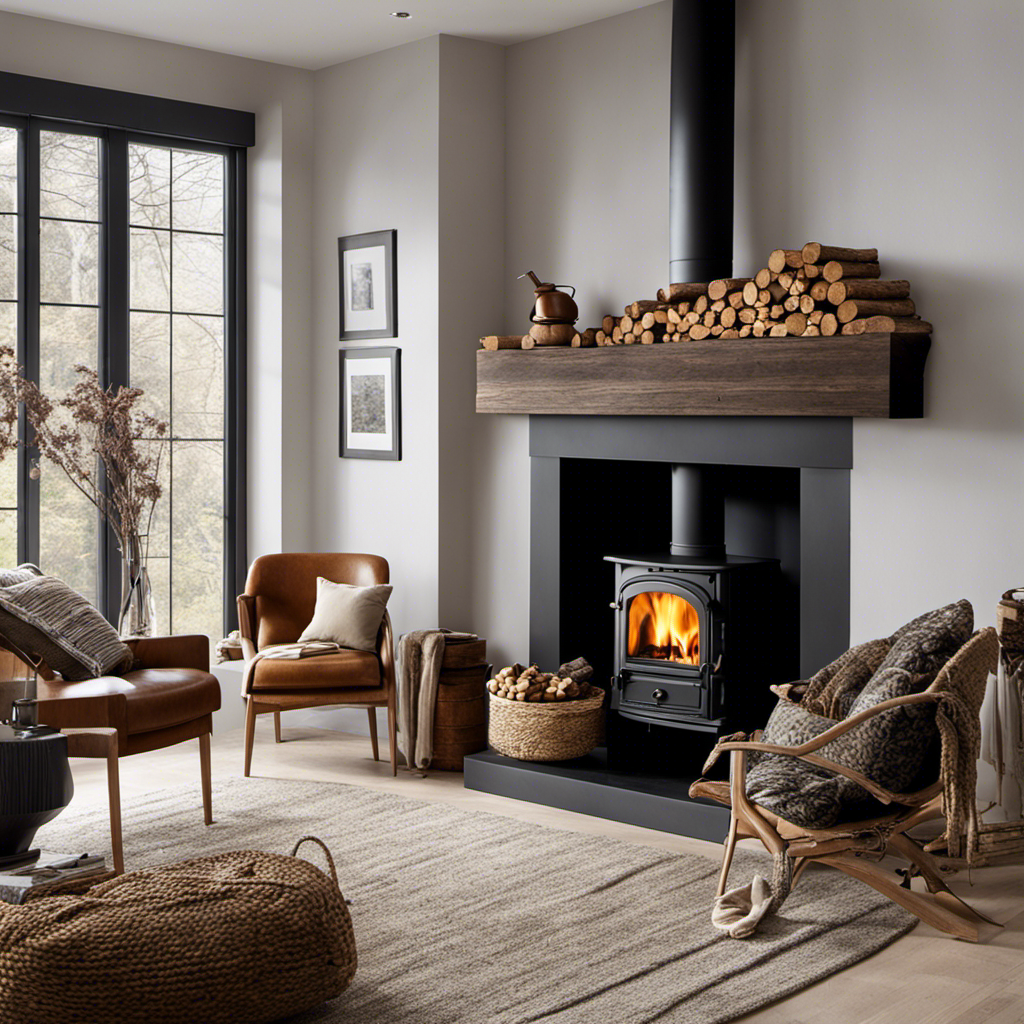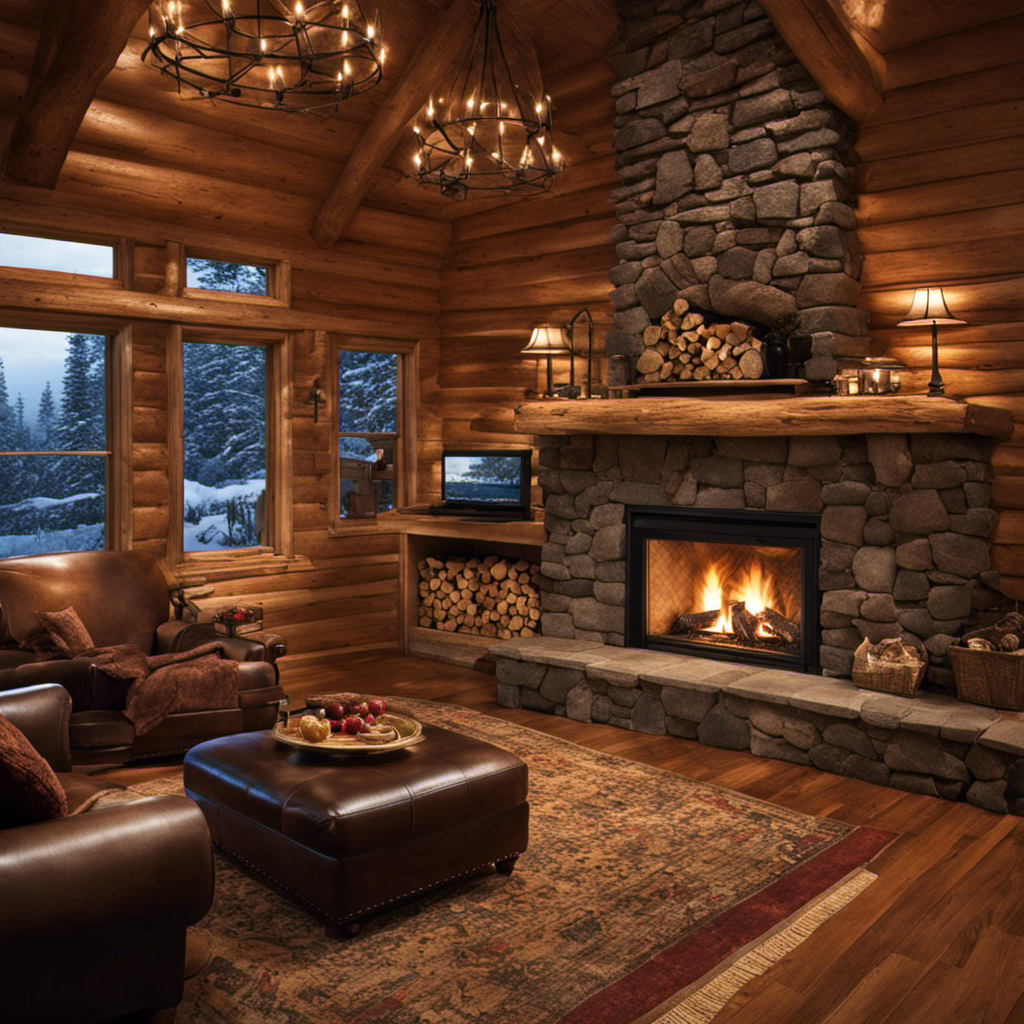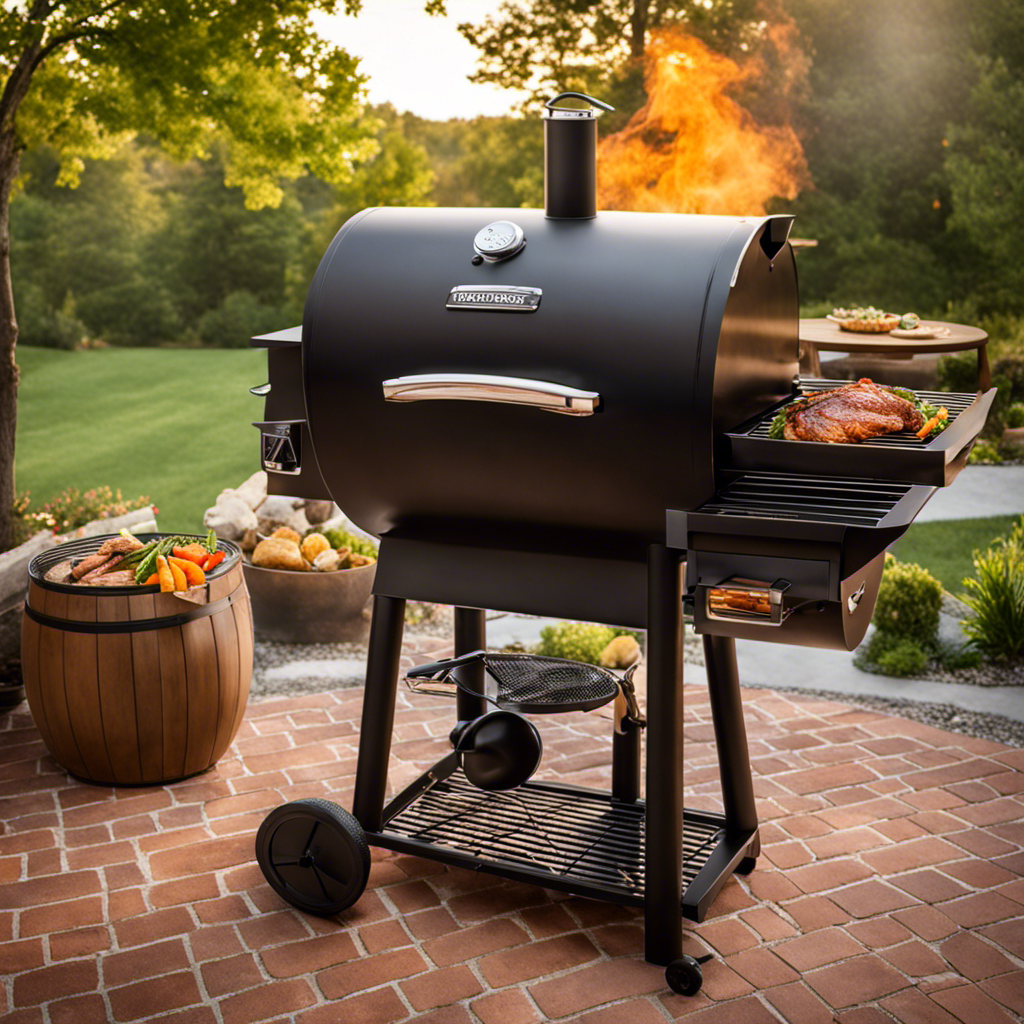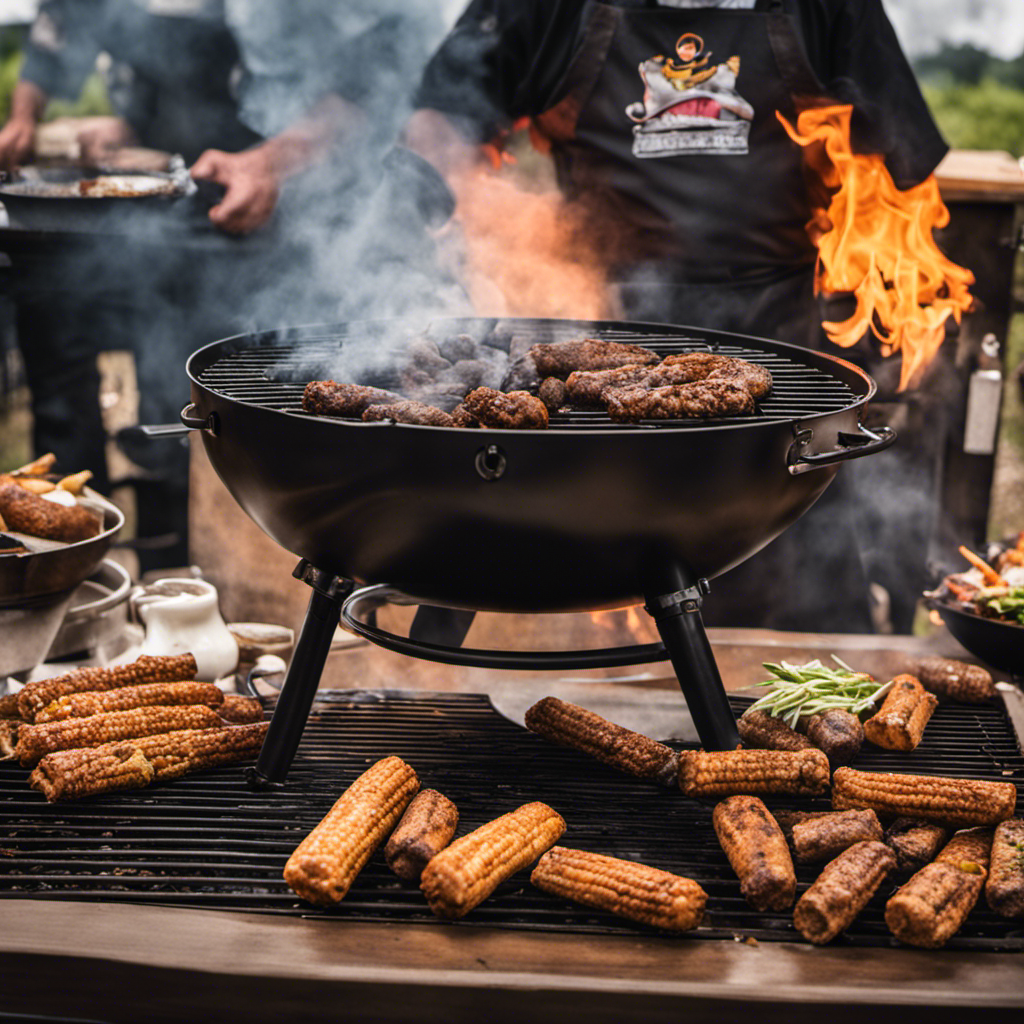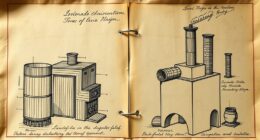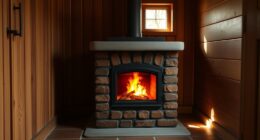My curiosity has always been piqued by the costs involved in heating a home with a wood burning stove or a pellet stove. Well, there’s no longer any need for speculation! In this article, we’re going to explore the detailed expenses related to installing and maintaining these heating options.
We’ll explore the factors that affect costs, calculate wood pellet usage expenses, and compare fuel costs between wood and pellets. Plus, we’ll discuss energy efficiency ratings and financial incentives that can help you save money in the long run.
So, let’s get started!
Key Takeaways
- The initial cost for wood burning stoves is lower compared to pellet stoves.
- Long-term fuel expenses for wood burning stoves can be offset by savings on heating costs.
- Pellet stoves use renewable and sustainable fuel sources, while wood burning stoves negatively impact air quality.
- Regular maintenance and occasional repairs are necessary for both types of stoves, with costs ranging from $50 to over $1000.
Cost of Wood Burning Stove Installation
The cost of installing a wood burning stove can be quite high, but it is worth considering for long-term savings on heating costs. Wood burning stoves typically have an initial cost ranging from $3,000 to $5,000, depending on the size and model chosen. However, it is important to consider the installation expenses as well.
On average, installation costs can range from $1,500 to $3,000, which includes the cost of labor, materials, and any additional modifications required for proper venting and safety compliance. While the upfront investment may seem substantial, the long-term savings on heating costs can offset these expenses.
Wood is generally more affordable than other heating fuels, such as natural gas or electricity. Additionally, wood burning stoves are known for their efficiency, with some models boasting heating efficiencies of up to 80%. This means that a significant amount of heat is generated from the wood, resulting in lower heating bills.
Transitioning to the subsequent section about expenses of pellet stove purchase, it is important to compare the costs and benefits of both options.
Expenses of Pellet Stove Purchase
When it comes to the expenses of purchasing a pellet stove, there are several key points to consider.
Firstly, the initial cost comparison between different pellet stove models can vary significantly based on factors such as brand, size, and features.
Secondly, the long-term fuel expenses of operating a pellet stove should be taken into account, as the cost of pellets can fluctuate depending on the region and availability.
Lastly, maintenance and repair costs should be considered, as regular maintenance and occasional repairs are necessary to ensure the efficient and safe operation of the pellet stove.
Initial Cost Comparison
To compare the initial costs of heating your house with a wood burning stove or a pellet stove, you should consider factors such as the cost of the stove itself, installation fees, and any additional accessories you may need. The cost of installation for both types of stoves can vary depending on factors such as the size of your house and the complexity of the installation process. Additionally, fuel efficiency is an important consideration when comparing the initial costs. A wood burning stove typically has a lower initial cost compared to a pellet stove, but pellet stoves are generally more fuel efficient. Here is a table that compares the initial costs of wood burning stoves and pellet stoves:
| Factor | Wood Burning Stove | Pellet Stove |
|---|---|---|
| Cost of stove | $1,000 – $3,000 | $1,500 – $4,000 |
| Installation fees | $500 – $1,500 | $1,000 – $2,500 |
| Additional accessories | $200 – $500 | $200 – $500 |
Considering these factors, it is important to analyze not only the initial costs but also the long-term fuel expenses of each type of stove.
Long-Term Fuel Expenses
Considering factors such as fuel efficiency and long-term costs, it’s important to carefully evaluate the expenses associated with each type of stove.
When it comes to wood burning and pellet stoves, one important aspect to consider is the availability of wood pellets. Wood pellets are typically made from sawdust or other byproducts of the wood industry, making them a renewable and sustainable fuel source. However, their availability may vary depending on the region and local suppliers.
Additionally, wood burning stoves can have a negative impact on air quality, releasing particulate matter and pollutants into the atmosphere. This can lead to health issues and environmental concerns.
Transitioning to the subsequent section about maintenance and repair costs, it’s essential to understand the overall expenses involved in owning and operating a wood or pellet stove.
Maintenance and Repair Costs
Maintaining and repairing your stove can be costly, so it’s important to budget for regular maintenance and any unexpected repairs that may arise. Here are some factors to consider when it comes to maintenance costs and repair expenses:
-
Regular maintenance:
-
Annual professional inspection and cleaning can cost around $100 to $200.
-
DIY maintenance, such as cleaning the flue and replacing gaskets, may cost around $50 to $100.
-
Unexpected repairs:
-
Common repair expenses include fixing or replacing the blower motor, thermostat, or ignition system, which can range from $200 to $500.
-
Major repairs, such as replacing the firebox or heat exchanger, can cost upwards of $1000.
It is important to keep these costs in mind when budgeting for your wood burning stove. Understanding the potential maintenance and repair expenses will help you make informed decisions regarding your heating system.
In the next section, we will explore the factors that can affect the overall cost of wood burning stoves.
Factors Affecting Wood Burning Stove Costs
When considering the expenses of a wood burning stove or pellet stove, it is important to take into account the type of stove, the installation process, and ongoing maintenance.
The type of stove chosen will greatly impact the overall cost, as certain models may be more expensive upfront but provide greater efficiency and long-term savings.
Additionally, installation costs can vary depending on factors such as the complexity of the installation, the need for additional ventilation, and any necessary modifications to the existing chimney or flue.
Regular maintenance is also crucial for optimal performance and safety, including cleaning, inspections, and potential repairs.
Type of Stove
A wood burning stove or pellet stove can be a cost-effective option for heating a house. When considering the type of stove, it’s important to understand the impact on heating efficiency. Here are three key factors to consider:
-
Stove Design: Different types of stoves have varying designs that affect heating efficiency. For example, a traditional wood burning stove may have a simple design that allows more heat to escape through the chimney. On the other hand, pellet stoves are designed with advanced technology that maximizes heat output while minimizing heat loss.
-
Fuel Type: The type of fuel used can also impact heating efficiency. Wood burning stoves typically burn logs or wood pellets, while pellet stoves exclusively use wood pellets. Wood pellets are denser and more uniform in size, leading to more consistent and efficient combustion.
-
Size and Power Output: Choosing the right size and power output for your stove is crucial for optimizing heating efficiency. A stove that is too small may struggle to adequately heat your home, while one that is too large may waste energy. Consider the size and layout of your space to determine the appropriate stove size and power output.
Considering these factors will help you select a stove that maximizes heating efficiency and reduces costs.
Now, let’s explore the installation and maintenance of wood burning and pellet stoves.
Installation and Maintenance
Now that we’ve discussed the different types of wood burning and pellet stoves available, let’s move on to the installation and maintenance costs associated with these heating systems.
The cost of installation for a wood burning stove or pellet stove can vary depending on factors such as the size and complexity of the installation, as well as the region you live in. On average, the installation cost can range from $1,000 to $5,000.
In terms of annual maintenance, wood burning stoves typically require more maintenance compared to pellet stoves. This includes regular chimney cleanings, ash removal, and inspections. On the other hand, pellet stoves require minimal maintenance, with the main task being the cleaning of the ash pan and regular inspection of the pellet feeder system.
Now that we understand the costs associated with installation and maintenance, let’s move on to calculating wood pellet usage costs…
Calculating Wood Pellet Usage Costs
To calculate wood pellet usage costs, you’ll need to consider the price per bag and the amount of pellets needed to heat your house. Efficiency ratings play a crucial role in determining how many pellets you’ll require. Higher efficiency stoves burn less fuel, meaning lower costs.
When comparing installation costs, it’s essential to factor in the cost of the stove itself, venting materials, and any additional components needed.
Now, let’s discuss maintenance and repair expenses for wood burning stoves. It’s important to keep your stove well-maintained to ensure optimal performance and safety. Regular cleaning, inspection, and servicing may be necessary, which could incur additional costs. It’s also wise to budget for any potential repairs or replacements that may arise over time.
Transitioning into the next section, proper maintenance and prompt repairs are crucial to prolonging the lifespan of your wood burning stove.
Maintenance and Repair Expenses for Wood Burning Stoves
You’ll need to budget for regular cleaning, inspection, and servicing to ensure optimal performance and safety of your wood-burning stove. Proper maintenance is crucial to keep your stove running efficiently and to avoid costly repairs down the line. Here are some common maintenance costs and repairs to consider:
-
Maintenance Costs:
-
Annual cleaning: $100-$200
-
Chimney sweep: $150-$300
-
Common Repairs:
-
Damaged firebricks: $50-$100 per brick
-
Door gasket replacement: $20-$50
-
Damaged glass replacement: $100-$200
Regular maintenance can help prevent major repairs and extend the lifespan of your wood-burning stove. By budgeting for these expenses, you can ensure that your stove operates at its best.
Now, let’s explore the next section, where we compare the fuel costs of wood and pellets.
Comparing Fuel Costs: Wood Vs. Pellets
Comparing the cost of fuel, wood pellets can be a more economical option for heating your home compared to traditional firewood. When calculating energy efficiency, wood pellets have a higher energy content and burn more efficiently than firewood. This means that you can heat your home with less fuel, resulting in cost savings over time.
Additionally, wood pellets are generally less expensive to purchase compared to firewood. In terms of environmental impact, wood pellets are considered a more sustainable option. They are made from compressed sawdust and other wood waste, which reduces the demand for virgin timber. This makes wood pellets a more environmentally friendly choice for heating your home.
Transitioning into the next section, let’s now explore the energy efficiency ratings for wood burning stoves.
Energy Efficiency Ratings for Wood Burning Stoves
When it comes to energy efficiency ratings, wood burning stoves can vary greatly depending on their design and features. These ratings are important as they determine how effectively the stove converts fuel into heat.
The higher the energy efficiency rating, the less fuel is wasted and the more heat is produced. Wood burning stoves with high energy efficiency ratings not only save money on fuel costs but also have a lower environmental impact. They emit fewer pollutants and reduce carbon emissions, contributing to a greener and cleaner environment.
Financial Incentives for Wood and Pellet Stove Installations
To take advantage of financial incentives for wood and pellet stove installations, consider researching available programs and contacting local authorities for more information. There are various financial incentives and government rebates available to help offset the cost of installing a wood or pellet stove in your home. These incentives can significantly reduce the upfront investment required for purchasing and installing a stove, making it a more affordable option for many homeowners.
Here is a table showcasing some of the common financial incentives and rebates available:
| Financial Incentives and Rebates | Description |
|---|---|
| Federal Tax Credits | Tax credits for energy-efficient home improvements |
| State and Local Rebates | Cash rebates provided by state and local governments |
| Utility Company Incentives | Incentives offered by utility companies for energy-efficient upgrades |
| Non-profit Grants | Grants provided by non-profit organizations for clean energy initiatives |
| Manufacturer Rebates | Rebates offered by stove manufacturers for promoting energy efficiency |
Long-Term Savings With Wood Burning or Pellet Stove Heating
By using a wood or pellet stove for heating, you can save money in the long run on your energy bills. Not only are wood and pellet stoves more cost-effective compared to traditional heating systems, but they also have a positive long-term environmental impact.
These stoves utilize renewable resources like wood pellets or logs, reducing reliance on fossil fuels. Additionally, wood and pellet stoves have high energy efficiency ratings, meaning they convert a larger percentage of fuel into usable heat for your home. This efficiency leads to lower energy consumption and decreased greenhouse gas emissions.
Investing in a wood or pellet stove not only saves you money but also contributes to a greener and more sustainable future.
Can a Wood Pellet Stove Provide Sufficient Heat for a House Like a Wood Burning Stove?
Yes, a high wood pellet stove flame can provide sufficient heat for a house, similar to a wood burning stove. Wood pellet stoves have a controlled flame and can efficiently heat a home, reducing the need for traditional wood stoves. They are also more environmentally friendly and easier to maintain.
Frequently Asked Questions
What Are the Benefits of Using a Wood Burning Stove or Pellet Stove Compared to Traditional Heating Methods?
Advantages of wood burning or pellet stoves compared to traditional heating include increased efficiency and cost savings. These stoves provide a sustainable and renewable heat source, reducing reliance on fossil fuels and lowering carbon emissions.
Is It Possible to Install a Wood Burning Stove or Pellet Stove in an Existing Home or Does It Require Specific Construction Modifications?
Installing a wood burning or pellet stove in an existing home may require specific construction modifications. These modifications can include adding a chimney or venting system and ensuring proper clearance from combustible materials.
Are There Any Regulations or Permits Required for Installing a Wood Burning Stove or Pellet Stove in a Residential Area?
There are regulations and permits required for installing a wood burning stove or pellet stove in a residential area. It is important to check with local authorities to ensure compliance with safety and environmental standards.
How Does the Cost of Wood or Pellets for a Stove Compare to the Cost of Other Heating Fuels Such as Natural Gas or Electricity?
Comparing the cost of wood or pellets for a stove to other heating fuels like natural gas or electricity, wood is generally cheaper. However, wood stoves are less efficient than gas or electric heaters.
Are There Any Potential Health or Environmental Concerns Associated With Using a Wood Burning Stove or Pellet Stove for Heating a House?
Using a wood burning or pellet stove for heating a house can have potential health concerns and environmental impacts. It’s important to consider air quality, emissions, and proper ventilation when using these types of stoves.
Conclusion
In conclusion, investing in a wood burning or pellet stove for heating your house can be a cost-effective choice in the long run.
According to a study conducted by the U.S. Department of Energy, wood burning stoves have an energy efficiency rating of around 70-80%, while pellet stoves have a higher rating of 80-90%. This means that these stoves can convert a significant amount of their fuel into heat, resulting in lower energy costs.
So, not only can you save money on heating expenses, but you can also contribute to a more sustainable and eco-friendly lifestyle.

